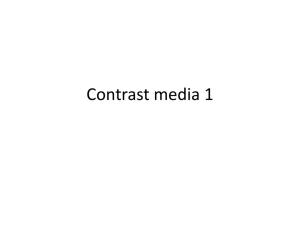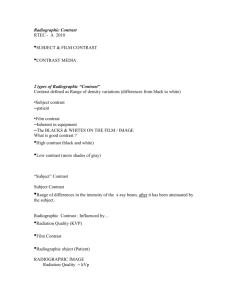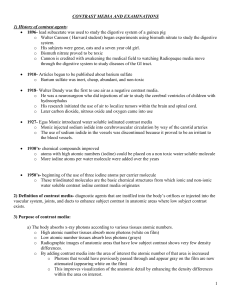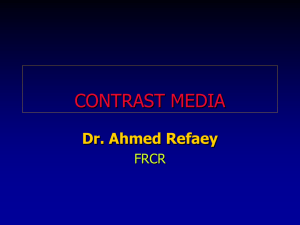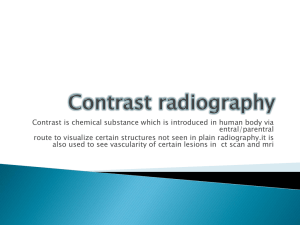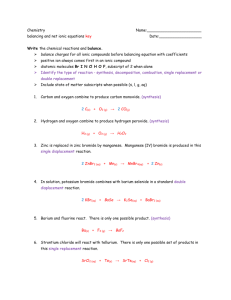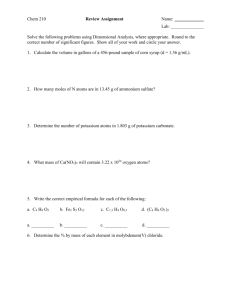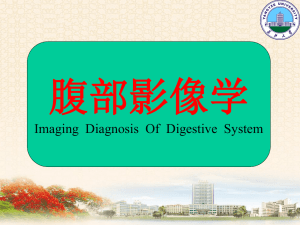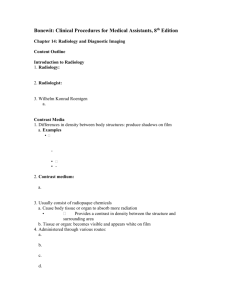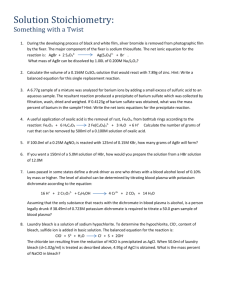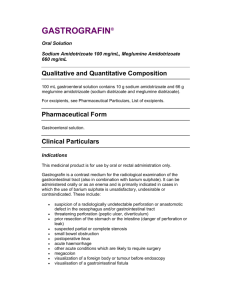Radiographic Contrast RTEC - A 2010 SUBJECT & FILM
advertisement
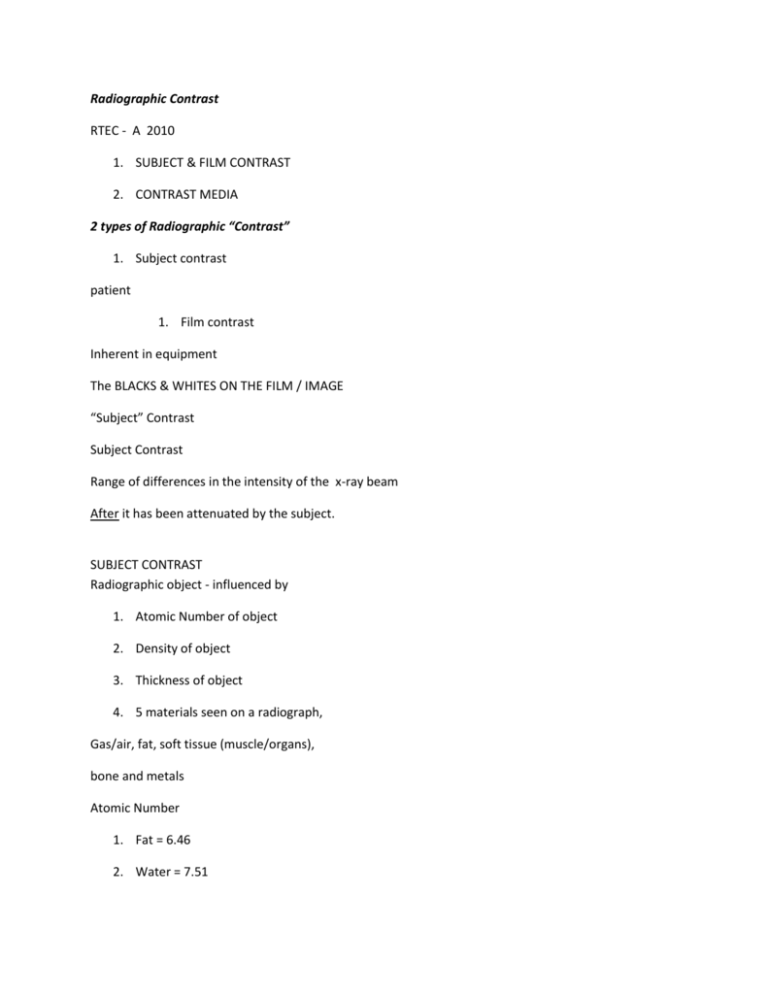
Radiographic Contrast RTEC - A 2010 1. SUBJECT & FILM CONTRAST 2. CONTRAST MEDIA 2 types of Radiographic “Contrast” 1. Subject contrast patient 1. Film contrast Inherent in equipment The BLACKS & WHITES ON THE FILM / IMAGE “Subject” Contrast Subject Contrast Range of differences in the intensity of the x-ray beam After it has been attenuated by the subject. SUBJECT CONTRAST Radiographic object - influenced by 1. Atomic Number of object 2. Density of object 3. Thickness of object 4. 5 materials seen on a radiograph, Gas/air, fat, soft tissue (muscle/organs), bone and metals Atomic Number 1. Fat = 6.46 2. Water = 7.51 3. Muscle = 7.64 4. Bone = 12.31 Tissue Subject Contrast 1. Atomic # of object 2. Density of object 3. Thickness of object 4. Higher atomic # = more attenuation 5. Denser = more attenuation 6. Thicker = more attenuation Film Contrast AKA Radiographic Contrast Radiographic Contrast influenced by: 1. Radiation Quality (KVP) 2. Film attributes 3. Radiographic object (Patient) What is good contrast ? 1. High contrast (black and white) 2. Low contrast (more shades of gray) RADIOGRAPHIC IMAGE Radiation Quality = kVp 1. High kVp ↑ 80 2. Low contrast 3. Lots shades of gray 4. Long Scale 5. Little differences in adjacent structures 6. Low kVp ↓ 70 7. High contrast 8. Black and White 9. Short Scale 10. Great differences in adjacent structures QUALITY – KVP A visible change in contrast will not be seen until kVp is changed 4-12 % kVp level change change in kVp 30-50 kVp 4-5 % 1-3 kVp 50-90 kVp 8-9 % 4-8 kVp 90-130 kVp 10-12 % 9-16 kVp Scenario Low subject contrast in the area of interest. You want to see the difference between muscle & fat & organs? What can be done to attain medical information and define organ structure and function? _____________________________________ Scenario Low subject contrast in the area of interest. You want to see the difference between muscle & fat & organs? What can be done to attain medical information and define organ structure and function? USE CONTRAST MEDIA Changing Subject Contrast with CONTRAST MEDIA Barium has a higher z# more asorbtion of photons Contrast Media changes the density of the organs Purpose of Contrast Media 1. To enhance subject contrast or render high subject contrast 1. In a tissue that normally has low subject contrast. 2. Creates bigger differences in atomic number (z #’s) Categories of Contrast Media Negative contrast 1. (AIR OR CO2) 2. Radiolucent 3. Low atomic # material 4. Black on film Positive contrast 1. (all others) 2. Radiopaque 3. High atomic # material 4. White on film 1. RADIOLUCENT - dark on image AIR, CO2 1. RADIOPAQUE - white on image BARIUM IODINE Negative Contrast 1. AIR / CO2 2. Naturally seen in the LUNGS STOMACH (gas in intestines) POSTIVE CONTRAST MEDIA 2 BASIC TYPES OF ‘”Positive” CONTRAST MEDIA BARIUM Z# 56 KVP 90 – 120* 1. NON WATER SOLUABLE 2. GI TRACT ONLY INGESTED OR RECTALLY IODINE Z# 53 KVP BELOW 90* USUALLY 70 – 80 KvP 1. WATER SOLUABLE 1. POWDER 2. LIQUID 3. INTRAVENOUS OR 4. GI TRACT 2. OIL BASED 1. DUCTS /ORGANS Positive Contrast Material INGESTED /INSTILLED (ORALLY OR RECTALLY) 1. BARUIM 2. IODINES GASTROGRAFIN HYPAQUE POWDER INJECTED IV – INTO BLOOD VESSELLS Organs and ducts 1. IODINES IONIC OR NON-IONIC VESSELLS & ORGANS 1. OIL BASED DUCTS /ORGANS ONLY Methods of Administration of Contrast Material 1. INGESTED / INSTILLED (ORALLY OR RECTALLY) 1. INJECTED IV – INTO BLOOD VESSELLS 1. RETROGRADE AGAINST NORMAL FLOW (Vessels & Organs) 1. INTRATHECAL Spinal canal 1. PARENTERAL 2. (IV, Intrathecal) Injecting into bloodstream (anything other than oral) BARIUM BARIUM SULFATE HISTORY OF BARIUM BaSo 4 1. LEAD SUBSTRATE – TOXIC 2. BISMUTH SUBNITRATE – TOXIC 3. THORIUM – RADIOACTIVE 4. BARIUM SULFATE - INERT 1. (goes in and comes out the same – not absorbed) 5. NOTE SOME PATIENT MAY SHOW ALLERGY TO SUSPENSION SOL. Barium Sulfate BaSO+ 1. High atomic number 2. Not soluble in water 3. Used to coat the lining of organs 4. Supplied in different thicknesses 5. Used 1. Esophogram, UGI, Small Bowel,Lower GI or BE Barium Sulfate BaSO+ 1. Because it is not water soluble – it must be mixed in a SUSPENSION with water 2. FLOCCULATION – when barium clumps (separates from the water) 3. Barium residue in the colon can dry and cause an obstruction 4. Drink plenty of fluids after exam BARIUM 1. MIXED IN A SUSPENSION 2. MUST BE SHAKEN 3. CHECK THE CAP (LID) FIRST !!!!!!! 4. SUSPENSION – sodium citrate, vegetal gums, flavoring and sweeteners to improve palatability ADVERSE REACTIONS 1. SUSPENSION MAY CAUSE ALLERGY 2. OCG TABLETS (IODINE) ALLERGY 3. AFTER EXAM – MAY SOLIDIFY DIFFICULT TO EVACUATE 4. INCREASE FLUIDS, MILD LAXATIVE 5. EXTRAVASATION OF CONTRAST INTO PERITONEUM BARIUM CONCENTRATION 1. DIFFERENT FOR EXAMS 2. W/W RATIO (weight/weight) 3. Mixture of barium to water – 100 g suspension 4. “THICK” VS “THIN” BARIUM BARIUM “THICK & THIN” 1. THICK – 1. DOUBLE CONTRAST 2. THIN – 1. SINGLE CONTRAST BARIUM ORAL OR RECTAL 1. LABELS ARE DIFFERENT 2. CHECK CAREFULLY BEFORE GIVING TO THE PATIENT Palatability OF BARIUM 1. Chalky taste with barium sulphate/water mixture 2. Contain a flavoring agent, sweetners 1. To disguise the unpleasant taste 3. Thicker or thinner suspensions may be used 3. Many commercial preparations contain carboxymethyl cellulose (Raybar, Barosperse) 1. Which retains fluid and prevents precipitation of the barium suspension in the normal small bowel GASTOINTESTINAL exams BARIUM COATS LINING OF INTESTINE 1. SINGLE CONTRAST - BARIUM ONLY 2. DOUBLE CONTRAST – WITH AIR CARBON DIOXIDE TABLETS – FIZZIES / CRYSTALS 1. SODA 2. ROOM AIR (LOWER GI) EXTRAVASATION 1. LEAKAGE THROUGH A DUCT OR VESSEL OR ORGAN INTO THE SURROUNDING TISSUE 2. Barium should not be given in cases of suspected perforation Extravasation 1. Following a Colonoscopy with biopsy Extravasation of BA in abd GASTROINTENSTIAL CONTRAST MEDIA PROCEDURES 1. ESOPHOGRAM / OPMS 2. UPPER GI (UGI) 3. SMALL BOWEL (SMBFT) 4. BARIUM ENEMA (BE) 5. GASTRO ENEMA Drinking Ba for Esophogram Hiatal Hernia Reflux “heartburn” Supplies for BE “DOUBLE CONTRAST” studies with Barium 1. Air used with other contrast agents 2. Better to see internal structures DOUBLE CONTRAST EXAMS 1. To achieve double contrast examination of the stomach, air or carbon dioxide gas must be introduced 2. Most radiologists use effervescent tablets (sodium bicarbonate , tartaric acid & calcium carbonate) 3. To react with the gastric contents to produce carbon dioxide BE SINGLE DOUBLE (AC) UGI double contrast single contrast DOUBLE CONTRAST WITH IODINE Iodine mixed with air of a bladder (canine) IODINE CONTRAST Iodine 1. Water Soluble 2. High atomic # 53 3. Radiopaque 4. Used to radiograph Vessels Arteries Veins Function of internal organs Gastrointestinal system Ducts IODINATED CONTRAST WATER BASED 1. INJECTED 2. VESSELLS/DUCTS 1. Ionic 2. Non-ionic 3. INGESTED or instilled 4. OPEN WOUNDS OIL BASED 1. INJECTED 2. NEVER VESSELLS 3. ONLY DUCTS 4. NOT INGESTED 5. OPEN WOUNDS Gastrointestinal studies: Gastrograffin or Hypaque (Iodine) 1. High atomic # Close to iodine 1. Water soluble 2. Similar usage as Barium Gastrograffin Water soluble iodine-containing contrast media are of value when there is a suspected perforation or leakage of an anastomosis after operation Oral or Rectal use GASTROGRAFIN POWDERED FORM – MIXED WITH H20 LIQUID IN BOTTLE – MAY BE MIXED USED WHEN PATIENTS ARE ILL, SUSPECTED PERFORATIONS PRE-OPERATIVELY (BITTER TASTE) CAN INCREASE PERISTALSIS (SMB STUDY) GASTROGRAFIN 1. Bitter taste 2. Better if chilled or mixed with ice 3. Monitor patient closely Gastrograffin via NG tube Peptic ulcer 1. Use Gastro 2. Contrast may leak 3. Into the peritoneum 4. Causing peritonitis Gastric neoplasm w/ perforation EXTRAVASATION OF CONTAST INTO THE PERITONEUM Gastrografin enema SINGLE CONTRAST ENEMA BARIUM (110 KVP) GASTROGRAFIN (90 KVP) GASTROGRAFIN Adverse Reactions 1. Water soluble, safe in the abdominal cavity Safe to use if perforation is suspected 1. Very harmful to the lung tissue Do not use if aspiration is possible Never force contrast Patient might aspirate into the lungs! INJECTABLE CONTRAST MEDIA INVASIVE PROCEDURES IVP / IVU Intravenous injections are INVASIVE ALWAYS GET PATIENT’S HISTORY AND CONSENT BEFORE BEGINNING OR GIVING ANY CONTRAST MEDIA Patient Assessment Check List Information update !! INJECTED CONTRAST 1. IODINE BASED 1. IONIC 2. NON IONIC IODINATED Contrast Agents IONIC High Osmolality (Higher risk of complications) 1. (Hypaque) 2. (Conray) NON-IONIC Low Osmolality (Lower risk of complications) 1. (Isovue) Iodine Contrast Material 1. Ionic Contrast Anion Cation + More patient allergic reactions 1. Ionic contrast media dissociates into two molecular particles in blood plasma = 2. Causing pt reactions Newer Contrast Agents Balance Safety and Visualization IODINE WATER BASED CONTRAST 1. IONIC 2. LESS $$$ $25 per bottle 1. MORE REACTIONS 2. NON IONIC 3. MORE $$$ $200 per bottle 1. LESS REACTIONS CONTRAST REACTIONS 1. > 10 million diagnostic procedures / year 2. Conventional ionic contrast reactions - 10% 3. 1 in 1000 severe Allergic to Iodine General Rule: 1. No Iodine Contrast will be given 1. Pre – medication is available 2. May or may not react if previous iodine given REACTIONS & Treatment USUALLY** WITHIN FIRST 5 MINUTES 1. Nausea & Vomiting & Urticaria 2. Hypotension (bradycardia) 3. Hypotension (tachycardia) 4. Bronchospasm 5. Anaphylactoid 6. Seizures 7. Extravasation ALWAYS –know the location of drug trays and crash carts INJECTED IODINE STUDIES GENITOURINARY Contrast injected into the VEIN 1. IVP / IVU 2. CYSTOGRAMS 3. (Retrograde may use a foley catheter) 4. GASTROINTESTINAL 5. ERCP – (CBD) 15 MIN POST CONTRAST INJECTION - IVP Cholelithiasis GB STONES Normal ERCP (checks for stones/blockage in bile duct) GB STONES Other Injected Contrast Studies Cerebral Angiogram Renal Arteriogram MYELOGRAM (SPINAL CORD) INTRATHECAL INJECTION Extravasation “To BE or not to BE” 1. Massive retroperitoneal air 2. pneumomediastinum 3. subcutaneous air 4. secondary to bowel perforation 5. after barium enema Extravasation of Contrast into soft tissue of arm Contrast leaking from bladder OIL – BASED IODINE CONTRAST Oil Based Iodine 1. Fatty Acids 2. Insoluble in water 1. White on the radiograph = Radiopaque 3. Uses 1. Bronchography (lungs) 2. Tear ducts 3. Salivary glands 4. Lymphatic system 5. Hysterrosalpingogram 6. Galactography (breast ducts) To check fertility LYMPHANGIOGRAM Galactography - Breast Duct Oral & IV contrast CT Scan CT showing Abnormal GB ORAL & IV CONTRAST (CT/ MRI)
